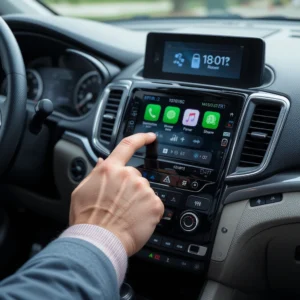In recent years, a notable shift has emerged in product design: the reintroduction of physical buttons in devices that had previously embraced touchscreens. This trend, observed in both consumer electronics and the automotive industry, raises important questions about user experience, safety, and the balance between innovation and practicality.
Apple’s Reintroduction of Physical Buttons
Apple, a pioneer in touchscreen technology, has taken a significant step by incorporating physical buttons into its latest devices. The iPhone 16 series, introduced in September 2024, features an “Action Button,” marking a departure from the company’s previous all-touch interface designs. This button provides users with quick access to various functions, enhancing usability. The Wall Street Journal highlighted this development, noting that “Apple is bringing back buttons” in response to user preferences for tactile controls.
The Action Button on the iPhone 16 allows users to customize its function, enabling quick access to features such as the camera, flashlight, or specific apps. This design change addresses the demand for more intuitive and accessible controls, especially for tasks that benefit from tactile feedback. The move signifies Apple’s recognition of the limitations inherent in touchscreen-only interfaces and its commitment to enhancing user experience through thoughtful design.
Volkswagen’s Shift Back to Physical Controls
The automotive industry has also experienced a resurgence of physical controls, with companies like Volkswagen leading the charge. The Verge reported that Volkswagen plans to reintroduce physical buttons in its future vehicles, starting with the ID.2all model. This decision comes after customer feedback indicated dissatisfaction with haptic sliders and touchscreens for essential functions like climate control and volume adjustment.
Volkswagen’s design chief acknowledged past mistakes and emphasized the company’s commitment to improving user experience by reverting to physical controls. The move aligns with new European Union safety regulations that require certain physical controls for a five-star safety rating. This regulatory shift underscores the importance of tactile interfaces in promoting driver safety and reducing distractions.
Safety Implications and User Preferences
The reintroduction of physical buttons is not merely a matter of nostalgia; it addresses critical safety concerns and user preferences. Touchscreen interfaces, while sleek and modern, have been associated with increased driver distraction. A study by the Swedish car magazine Vi Bilägare found that drivers using touchscreens took longer to perform simple tasks compared to those using physical buttons, highlighting the potential safety risks of touchscreen-heavy designs.
The study involved testing various car models, including those with touchscreens and those with physical buttons, to perform tasks such as adjusting climate control and radio settings. The results indicated that drivers using touchscreens had to divert their attention from the road for longer periods, increasing the risk of accidents. This finding has prompted automakers to reconsider the balance between modern interface designs and practical safety considerations.
Industry-Wide Reevaluation
Volkswagen is not alone in this reevaluation. Other automakers, such as Hyundai and Kia, have also faced customer dissatisfaction with touchscreen-heavy interfaces and are re-assessing their designs. The Verge noted that these companies are responding to user feedback by incorporating more physical controls in their vehicles, aiming to improve usability and safety.
This industry-wide shift reflects a broader recognition that while touchscreens offer flexibility and a modern aesthetic, they may not always provide the most user-friendly or safest interface, especially in contexts like driving where tactile feedback is crucial. The move back to physical buttons suggests a more nuanced approach to design, one that considers the specific needs and contexts of users.
The Balance Between Innovation and Usability
The resurgence of physical buttons raises important questions about the balance between technological innovation and practical usability. While touchscreens have enabled more dynamic and customizable interfaces, they often lack the tactile feedback that allows users to operate controls without visual confirmation. This absence can lead to increased cognitive load and distraction, particularly in situations that require sustained attention, such as driving.
The reintroduction of physical buttons represents a shift towards prioritizing user experience and safety over minimalist design trends. It acknowledges that while innovation is essential, it should not come at the expense of functionality and user well-being. This perspective aligns with the principles of user-centered design, which emphasize designing products that meet the actual needs and preferences of users.
Conclusion: Usability and Safety at the Forefront
The trend of reintroducing physical buttons in both consumer electronics and automobiles underscores a critical insight: usability and safety are paramount in design considerations. While touchscreens offer versatility and have become a symbol of modern design, they are not always the optimal choice for every function or context.
By incorporating physical buttons, companies like Apple and Volkswagen are responding to user feedback and empirical evidence highlighting the benefits of tactile controls. This approach enhances user satisfaction and addresses safety concerns associated with touchscreen interfaces. It reflects a mature understanding that innovation should enhance, not hinder, the user experience.
In conclusion, the reintroduction of physical buttons signifies a thoughtful balance between embracing new technologies and honoring the fundamental principles of usability and safety. As industries continue to evolve, keeping the user’s needs at the center of design decisions will remain crucial for creating products that are both innovative and practical.
